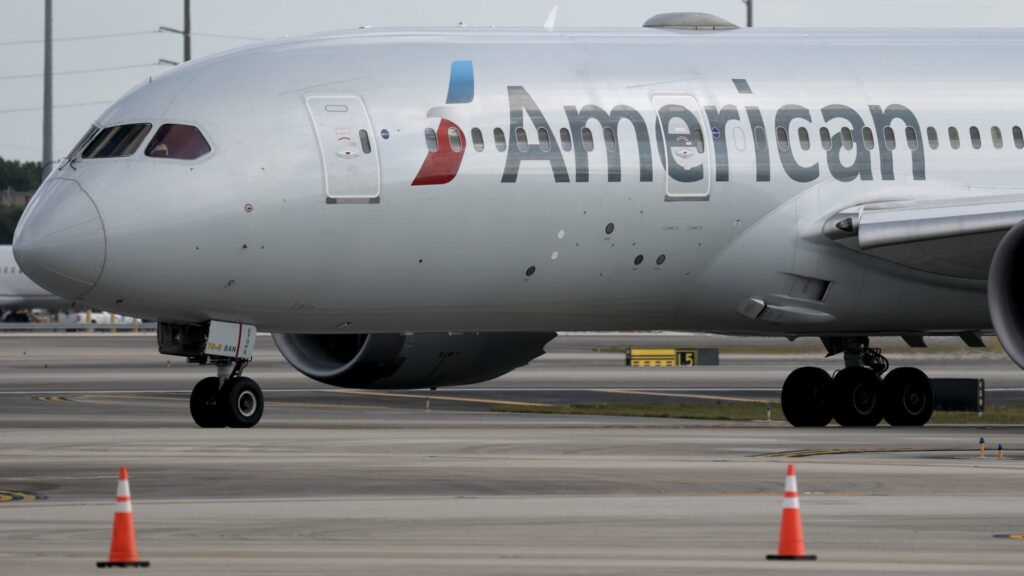
American Airlines Q1 2025 Earnings: Carrier Withdraws Guidance Amid Leisure Travel Slowdown
American Airlines Q1 2025 Earnings: Carrier Withdraws Guidance Amid Leisure Travel Slowdown
American Airlines has withdrawn its 2025 financial guidance after reporting disappointing Q1 2025 earnings results. (Image: Company Press Resource)
American Airlines (AAL) has withdrawn its full-year 2025 financial guidance following the release of its American Airlines Q1 2025 earnings report on Thursday. The carrier joins several other major airlines grappling with an uncertain U.S. economic outlook and weaker-than-expected leisure travel bookings in the domestic market this year.
Table of Contents
Key American Airlines Q1 2025 Earnings Metrics
The American Airlines Q1 2025 earnings report revealed a loss of $473 million for the quarter, significantly wider than the $312 million loss posted in the same period last year. Revenue remained nearly unchanged at $12.55 billion compared to the first quarter of 2024.
While the adjusted loss per share of 59 cents was slightly better than analysts’ expectations of a 65-cent loss, the revenue figure of $12.55 billion fell just short of the $12.6 billion forecast by Wall Street analysts compiled by LSEG. These mixed American Airlines Q1 2025 earnings results reflect the challenging operating environment facing carriers.
Why American Airlines Withdrew 2025 Guidance
In a significant move that caught investors’ attention, American Airlines withdrew its financial guidance for the full year 2025 as part of its Q1 2025 earnings announcement. This decision follows similar moves by industry competitors facing uncertain market conditions.
“We came off a strong fourth quarter, saw decent business in January and really domestic leisure travel fell off considerably as we went into the February time frame,” CEO Robert Isom told CNBC’s “Squawk Box” on Thursday.
The sudden decline in domestic leisure travel bookings starting in February has created significant uncertainty about the carrier’s financial performance for the remainder of the year. While international bookings remain strong, the domestic leisure market, which represents a substantial portion of American’s business, has shown concerning weakness.
Market Reaction to American Airlines Q1 2025 Earnings
The withdrawal of full-year guidance typically signals increased uncertainty to investors. This move, combined with the weaker-than-expected revenue and wider year-over-year loss, creates challenges for market analysts attempting to model American Airlines’ financial performance through the remainder of 2025.
Domestic Leisure Travel Decline
A key insight from the American Airlines Q1 2025 earnings call was the significant decline in domestic leisure travel demand starting in February 2025. This trend mirrors reports from other major U.S. carriers, suggesting an industry-wide challenge rather than an American Airlines-specific issue.
The airline reported that the modest 0.7% increase in unit revenue during the first quarter was primarily driven by strength in international bookings and premium cabin performance. This pattern aligns with statements from competitors Delta and United, both of which indicated that price-sensitive leisure travelers have been the demographic most likely to cut back on travel plans.
Industry analysts have noted that domestic leisure travel was the segment that recovered most quickly after the pandemic, and its current weakness may signal broader economic concerns among U.S. consumers as inflation and economic uncertainty continue to impact discretionary spending decisions.
Q2 2025 Revenue and Capacity Forecast
Looking ahead, the American Airlines Q1 2025 earnings presentation included forecasts for the second quarter that fell below analyst expectations:
- Q2 Revenue: Between 2% down and 1% up compared to Q2 2024 (below the 2.2% growth expected by Wall Street)
- Q2 Capacity: Expected to increase 2-4% year-over-year
- Q2 Adjusted EPS: Forecast between $0.50 and $1.00 per share (below the $0.99 consensus)
The projected increase in capacity alongside potentially declining revenue suggests American is facing yield pressure as it attempts to stimulate demand through more competitive pricing, a strategy that could further pressure profit margins in the second quarter.
Understanding Airline Capacity and Revenue Dynamics
When an airline increases capacity (available seat miles) while revenue remains flat or declines, it typically indicates lower load factors (percentage of seats filled) or reduced yields (average fare per passenger). This combination can significantly impact profitability, as airlines have high fixed costs regardless of how many seats they fill.
Challenges Affecting Performance
The American Airlines Q1 2025 earnings report highlighted several specific challenges that have impacted the carrier’s financial performance:
Factors Cited in American’s Q1 Performance
- Declining domestic leisure demand beginning in February 2025
- Economic uncertainty affecting consumer travel decisions
- American Eagle Flight 5342 accident – the January collision with an Army helicopter in Washington D.C. that killed all 67 people aboard both aircraft
- Ongoing recovery from a “failed business strategy” in the corporate travel segment
The tragic accident involving American Eagle Flight 5342 represents a significant emotional and operational challenge for the airline. Such events can impact consumer confidence and booking patterns for months following the incident, creating additional headwinds for the carrier’s recovery efforts.
Additionally, American noted progress in rebuilding its corporate travel business, though these gains were offset by the broader economic uncertainty and domestic leisure travel weakness identified in the Q1 2025 earnings report.
How American Compares to Industry Peers
The challenges highlighted in the American Airlines Q1 2025 earnings report are not unique to American, as several major U.S. carriers have reported similar trends in their financial results:
| Airline | Q1 2025 Performance | Guidance Status | Notable Trends |
|---|---|---|---|
| American Airlines | $473M loss; Revenue flat | Withdrawn for 2025 | Domestic leisure weakness; International strength |
| Delta Air Lines | Profit, but below expectations | Lowered 2025 guidance | Premium cabin strength; Basic economy weakness |
| United Airlines | Better than expected results | Maintained with caution | Strong international demand; Price-sensitive travelers pulling back |
The industry-wide pattern of international and premium travel strength, coupled with domestic leisure weakness, suggests a potential bifurcation in the travel market. Higher-income travelers and business travelers appear to be maintaining their travel patterns, while more price-sensitive segments are cutting back.
Looking Beyond the American Airlines Q1 2025 Earnings
The coming months will be critical for American Airlines and the broader airline industry as they navigate the apparent shift in travel demand patterns. The summer travel season, which typically brings stronger bookings and higher yields, will provide important indications of whether the current weakness in domestic leisure travel represents a temporary pullback or a more sustained trend that could affect airline profitability throughout 2025.
As American Airlines works to adjust its strategy in response to the challenges identified in its Q1 2025 earnings report, investors and industry observers will be closely monitoring booking trends, capacity adjustments, and pricing strategies across the airline’s network. The carrier’s ability to leverage its strengths in international and premium travel while addressing the weakness in domestic leisure demand will likely determine its financial performance for the remainder of the year.






